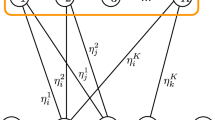Abstract
In the past three decades, the properties of associative networks has been extensively investigated. However, most existing results focus on the fault-free networks only. In implementation, network faults can be exhibited in different forms, such as open weight fault and multiplicative weight noise. This paper studies the effect of weight fault on the performance of the bidirectional associative memory (BAM) model when multiplicative weight noise and open weight fault present. Assuming that connection weights are corrupted by these two common fault models, we study how many number of pattern pairs can be stored in a faulty BAM. Since one of important feature of associative network is error correction, we also study the number of pattern pairs can be stored in a faulty BAM when there are some errors in the initial stimulus pattern.





Similar content being viewed by others
References
Kohonen T (1972) Correlation matrix memories. IEEE Trans Comput 21:353–359
Palm G (1980) On associative memory. Biolog Cybern 36:19–31
Kosko B (1988) Bidirectional associative memories. IEEE Trans Syst Man Cybern 18:49–60
Haines K, Hecht-Nielsen R (1988) A bam with increased information storage capacity. In: Proceedings of the 1988 IEEE international conference on neural networks, pp 181–190
Amari S (1988) Statistical neurodynamics of various versions of correlation associative memory. In: Proceedings of the 1988 IEEE international conference on neural networks, pp 181–190
Oapos SEM, Austin J (1994) An application of an associative memory to the analysis of document images. In: Proceedings of the British machine vision conference
Chau FT, Cheung B, Tam KY, Li LK (1995) Application of a bi-directional associative memory (bam) network in computer assisted learning in chemistry. Comput chem 18(4):359–362
Ruz-Hernandez JA, Sanchez EN, Suarez DA (2006) Designing an associative memory via optimal training for fault diagnosis. In: Proceedings of IJCNN’06, pp 4338–4345
Wang YF, Cruz JB, Mulligan JH (1990) Two coding strategies for bidirectional associative memory. IEEE Trans Neural Netw 1:81–92
Leung CS (1993) Encoding method for bidirectional associative memory using projection on convex sets. IEEE Trans Neural Netw 4:879–991
Leung CS (1994) Optimum learning for bidirectional associative memory in the sense of capacity. IEEE Trans Syst Man Cybern 24:791–796
Lenze B (2001) Improving Leung’s bidirectional learning rule for associative memories. IEEE Trans Neural Netw 12:1222–1226
Shen D, Cruz JB (2005) Encoding strategy for maximum noise tolerance bidirectional associative memory. IEEE Trans Neural Netw 16:293–300
Simpson PK (1990) Higher-ordered and intraconnected bidirectional associative memories. IEEE Trans Syst Man Cybern 20:637–653
Leung CS, Chan LW (1997) The behavior of forgetting learning in bidirectional associative memory. Neural Comput 9:385–401
Leung CS, Chan LW, Lai E (1997) Stability and statistical properties of second-order bidirectional associative memory. IEEE Trans Neural Netw 8:267–277
Burr JB (1991) Digital neural network implementations. Neural Netw Concepts Appl Implement III:237–285
Himavathi S, Anitha D, Muthuramalingam A (2007) Feedforward neural network implementation in fpga using layer multiplexing for effective resource utilization. IEEE Trans Neural Netw 18:880–888
Antony MM, Savich W, Areibi S (2007) The impact of arithmetic representation on implementing mlp-bp on fpgas: a study. IEEE Trans Neural Netw 18:240–252
Kaneko T, Liu B (1970) Effect of coefficient rounding in floating-point digital filters. IEEE Trans Aerosp Electron Syst AE-7:995–1003
Liu B, Kaneko T (1969) Error angalysis of digital filter realized with floating-point arithemetic. Proc IEEE 57:1735–1747
Phatak DS, Koren I (1995) Complete and partial fault tolerance of feedforward neural nets. IEEE Trans Neural Netw 6:446–456
Emmerson MD, Damper RI (1993) Determining and improving the fault tolerance of multilayer perceptrons in a pattern-recognition application. IEEE Trans Neural Netw 4:788–793
Zhou ZH, Chen SF (2003) Evolving fault-tolerant neural networks. Neural Comput Appl 11:156–160
Sing LC, John S (2008) A fault-tolerant regularizer for rbf networks. IEEE Trans Neural Netw 19:493–507
Bolt G (1991) Fault models for artificial neural networks. In: 1991 IEEE international joint conference on neural networks, vol 2, pp 1373–1378
Sossa H, Barron R, Vazquez RA (2007) Study of the influence of noise in the values of a median associative memory. In: ICANNGA 2007 (2), NCS 4432
Acknowledgements
The work presented in this paper is supported by a research grant from the City University of Hong Kong (Project No. 7002480).
Author information
Authors and Affiliations
Corresponding author
Additional information
The work presented in this paper is supported by a research grant from the City University of Hong Kong (Project No. 7002480).
Rights and permissions
About this article
Cite this article
Leung, A.CS., Sum, P.F. & Ho, K. The effect of weight fault on associative networks. Neural Comput & Applic 20, 113–121 (2011). https://doi.org/10.1007/s00521-010-0351-2
Received:
Accepted:
Published:
Issue Date:
DOI: https://doi.org/10.1007/s00521-010-0351-2




